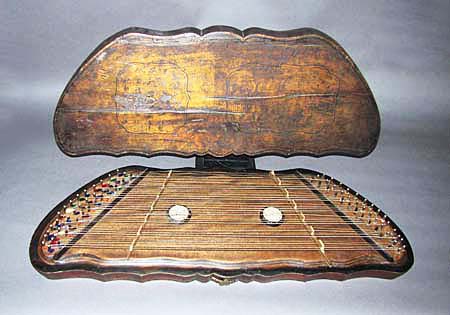
Owner: HWMC
Catalogue #: AS-CHZT-09
Zithers
China 'Yangqin' (Pre-19th century)
Kuang-tung Province, China
Chinese
Wood, brass strings, ivory
Pre-19th century
Length: 46.2 in. (near edge); 30.5 in. (far edge)
Chordophones – Zithers
The yangqin or yang qin (pronounced young-ch’in) is affectionately called “butterfly harp” due to its unique shape. It is a hammered string dulcimer with a trapezoidal shape base. The yangqin is said to have been developed from a similar Indian and Persian instrument, the santur. It was first introduced into China during the Ming Dynasty (1600 A.D.). This hammered dulcimer instrument of the Pre-19th century comes from Kuang-tung Province, China. The inside of the lid has carvings of Chinese script.
The yangqin was adopted and adapted by the people of Thailand, Cambodia, and Lao from China and called a khim (khimm) during the late Ayutthya period (1767 C.E.). The name khim is a borrowed word from the Chinese Fujian dialect meaning music or music instrument or qin in Mandarin.
Resource: “Yangqin,” Alan R. Thrasher / Gloria N. Wong, “The Grove Dictionary of Musical Instruments”, 2nd ed. Vol.3, Laurence Libin, Editor in Chief. Oxford University Press
Resource: Presentation at The Syncretism in South and Southeast Asia: Adoption and Adaptation of South and Southeast Asian Association for the Study of Culture and Religion. Bangkok, Thailand, May 22-24, 2007, Jintana T. Barton, Faculty of Arts, Chulalongkorn University.
